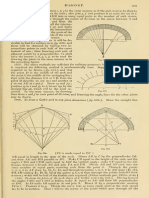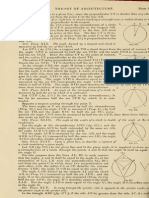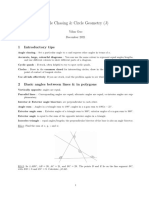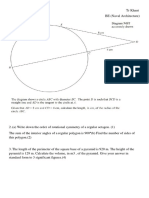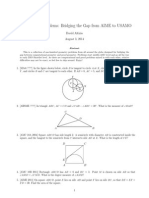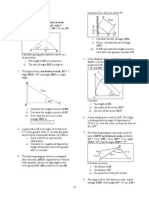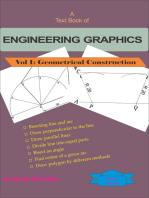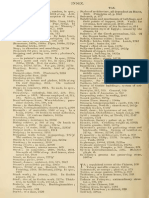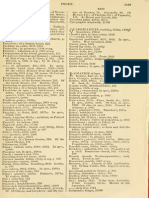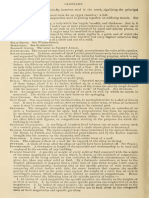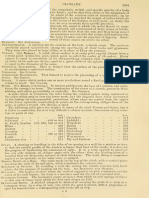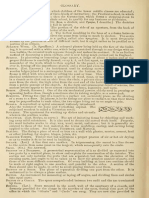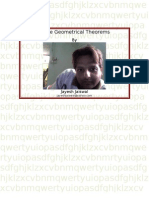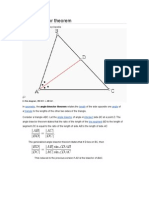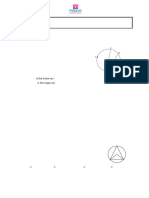0 ratings0% found this document useful (0 votes)
69 viewsEN
EN
Uploaded by
reacharunkThe document describes several geometric constructions:
1) To inscribe a circle in a regular polygon, bisect any two sides with perpendiculars to find the center.
2) To circumscribe a circle about a regular polygon, bisect two angles to find the center.
3) Several constructions are given to make one shape equal to another, such as making a triangle equal to a quadrilateral or pentagon.
4) Constructions are also provided to draw curves like a catenary, cycloid, and diagonal scale.
Copyright:
© All Rights Reserved
Available Formats
Download as PDF, TXT or read online from Scribd
EN
EN
Uploaded by
reacharunk0 ratings0% found this document useful (0 votes)
69 views1 pageThe document describes several geometric constructions:
1) To inscribe a circle in a regular polygon, bisect any two sides with perpendiculars to find the center.
2) To circumscribe a circle about a regular polygon, bisect two angles to find the center.
3) Several constructions are given to make one shape equal to another, such as making a triangle equal to a quadrilateral or pentagon.
4) Constructions are also provided to draw curves like a catenary, cycloid, and diagonal scale.
Original Description:
ljljljlkj
Original Title
EN(317)
Copyright
© © All Rights Reserved
Available Formats
PDF, TXT or read online from Scribd
Share this document
Did you find this document useful?
Is this content inappropriate?
The document describes several geometric constructions:
1) To inscribe a circle in a regular polygon, bisect any two sides with perpendiculars to find the center.
2) To circumscribe a circle about a regular polygon, bisect two angles to find the center.
3) Several constructions are given to make one shape equal to another, such as making a triangle equal to a quadrilateral or pentagon.
4) Constructions are also provided to draw curves like a catenary, cycloid, and diagonal scale.
Copyright:
© All Rights Reserved
Available Formats
Download as PDF, TXT or read online from Scribd
Download as pdf or txt
0 ratings0% found this document useful (0 votes)
69 views1 pageEN
EN
Uploaded by
reacharunkThe document describes several geometric constructions:
1) To inscribe a circle in a regular polygon, bisect any two sides with perpendiculars to find the center.
2) To circumscribe a circle about a regular polygon, bisect two angles to find the center.
3) Several constructions are given to make one shape equal to another, such as making a triangle equal to a quadrilateral or pentagon.
4) Constructions are also provided to draw curves like a catenary, cycloid, and diagonal scale.
Copyright:
© All Rights Reserved
Available Formats
Download as PDF, TXT or read online from Scribd
Download as pdf or txt
You are on page 1of 1
Chai". T.
rilACTlCAL GEOMKTKY. 995
3'
6.). and
wi.l be the
tlicn tliejf
Kig. .-.ST. FiR. r,s.i.
AB
Fir. 90.
1024. Pkok. XXVIII. Tn inscribe a circle in a reuvlar puli/c/on.
Iji.sect any two sides of tlie polygon by tlie perpeadiciilais GO, VO
(
fo.
tliL'H- intersection O will be the centre of the inscribed circle, and OG or OF
radius.
1025. Pror. XXIX. To (hscrihe a circ/e about a reqvlnr pnli/cnn.
Bisect any two of tlie angles C and D witli tlie lines CO, DO (j^^r. 387.),
hilersectiou O will be the centre of the cir-
a
cir.nscribing circle; and OC or OD will be
the radius.
1026. Pkob. XXX. To mahe a triangle
equal to a given quadrilateral ABCD.
Draw the diagonal AC
{Jig.
388.), and
parallel to it DE, meeting BA produced at
E, and join CE; then will the triangle CEB
he e<]ual to the given quadrilateral ABCD.
1027. PiioB. XXXI. To ntdiie a triangle egnal to a given pentagon ABCDl
Draw DA and DB, and also EE, CG parallel to them
{fy.
389.), meetii
duced at F and G ; then draw Dl' and
^
DG, so shall the triangle DFG be equal to
the given pentagon ABCDE.
1028. Pkob. XXXII. To make a rect-
angle equal to a given triangle ABC.
Bisect the base AB in D
(fg
390.), then
raise DE and BF perpendicular to AB, and
meeting CF parallel to AB at E and F.
Then DF will be the rectangle equal to
the- given triangle ABC.
1029. Pkob. XXXIII. To make a square equal to a given rectangle ABCD.
Produce one side AB till BE be equal to the other side BC
{Jig. 391.). On AE as a
diameter describe a circle meeting BC pro-
duced at F, then will liV be the side of
the square BFGH equal to the given rect-
angle BD, as required.
1030. Pkob. XXXIV. To draw a cate-
iiari/, c C d
(Jig.
.392.)
A catenary is a curve formed by a flexible
cord or chain suspended by its two extremi-
ties. Let c, d, in the line A B {_fig. 392.) he the two points of suspension, ar.d fioni tliem
let the cord or chain be bung so as to touch the point C tlie given depth. From this the
curve may be traced on the ()aper.
1031. Pkob. XXXV. 2"u draw a cycliid.
Any points b
{fig.
393.) in the circum'erence of a circle
rolled along a riglit line AB till such point is again in contact
with tlie sdid line, generate a cycloid. Let BC be the circle.
'I'heii AB is eipial to the semi-circumference of such circle,
and any chords at whose extremities b, lines nb, ali, e<jual to
the lengths of arcs they cut otf, drawn parallel to AB, will
furnish the necessary points for forming the curve.
1032. PaoB XXXVI. 2'o draiv a diagonal t.C(ile.
Let it be of feet, tenths and hundredth parts of a foot.
many times as necessary, the number of feet by equal
distances. Divide AG ir.to ten etjual parts. On AB
i)
raise the perpendiculars BD, GG, and AC, and set oil'
on AC ten ctjual divi.'>ions of any conveniiut lengtli,
throiigli which draw horizontal lint'S. The.i, from the
point G in DC to the Krst tenth part from G to A in
B.A draw a diagonal, and jiarallel thereto tlie other
diagonals reciulred. The intersections of tiiese liiago
nals with the horizontal lines give liundredtli i)arts of
a foot, inasmuch as each tenth is divided by the diago-
nals into tea equal parts in descending.
Fig. 39
Set ott'on AB
{Jig.
39-1.) as
You might also like
- Euclid Contest: Canadian Mathematics CompetitionDocument4 pagesEuclid Contest: Canadian Mathematics Competitionสฮาบูดีน สาและNo ratings yet
- Geometry.: PuacticalDocument1 pageGeometry.: PuacticalreacharunkNo ratings yet
- Theory: of ArchitectureDocument1 pageTheory: of ArchitecturereacharunkNo ratings yet
- Theory: of ArchitectureDocument1 pageTheory: of ArchitecturereacharunkNo ratings yet
- Guess Paper - 2012 Class - IX Subject - : MathematicsDocument4 pagesGuess Paper - 2012 Class - IX Subject - : MathematicsGursimar SinghNo ratings yet
- trigo geo worksheetDocument8 pagestrigo geo worksheetaditi.bhasinNo ratings yet
- G, F Many Number From: It It 15 eDocument1 pageG, F Many Number From: It It 15 ereacharunkNo ratings yet
- TD ATD: TheoryDocument1 pageTD ATD: TheoryreacharunkNo ratings yet
- Theory: of ArchitectureDocument1 pageTheory: of ArchitecturereacharunkNo ratings yet
- Circle 9.3Document12 pagesCircle 9.3ambastreaming913No ratings yet
- DC FM: TheoryDocument1 pageDC FM: TheoryreacharunkNo ratings yet
- geometry2Document8 pagesgeometry2aditi.bhasinNo ratings yet
- 28-Trigonometry Paper 2Document6 pages28-Trigonometry Paper 2iyaad MubarakNo ratings yet
- Second Term WK 2Document3 pagesSecond Term WK 2Ayodele EmmanuelNo ratings yet
- 4 - Cyclic QuadrilateralsDocument4 pages4 - Cyclic Quadrilateralsbuurning100% (1)
- MK KM: The Many May Our How WhenDocument1 pageMK KM: The Many May Our How WhenreacharunkNo ratings yet
- Subject-Mathematics, Class-Ix Circles: Worksheet (Basic)Document7 pagesSubject-Mathematics, Class-Ix Circles: Worksheet (Basic)sanjayb1976gmailcom100% (1)
- FL FG FL A: Al Al Afl Al Af Al Af FG BCDDocument1 pageFL FG FL A: Al Al Afl Al Af Al Af FG BCDreacharunkNo ratings yet
- 1701832667764.QP PS CB IX Math CirclesDocument7 pages1701832667764.QP PS CB IX Math Circleskabbur.anushkaNo ratings yet
- Final Problems EngDocument6 pagesFinal Problems Engmathlinks1990No ratings yet
- Disentangling A Triangle: Jerzy Kocik and Andrzej SoleckiDocument10 pagesDisentangling A Triangle: Jerzy Kocik and Andrzej Soleckiyurt_manNo ratings yet
- BD AD: Its TlieDocument1 pageBD AD: Its TliereacharunkNo ratings yet
- Angle - Chasing J y - Guo Dec21Document4 pagesAngle - Chasing J y - Guo Dec21Jason Wenxuan MIAONo ratings yet
- CLASS IX PA-II (MATHEMATICS) BY ABHISHEK KUMARDocument7 pagesCLASS IX PA-II (MATHEMATICS) BY ABHISHEK KUMARsingh.abhi.yadavNo ratings yet
- ENDocument1 pageENreacharunkNo ratings yet
- ConstructionsDocument12 pagesConstructionslakshay mittalNo ratings yet
- 2016-2018 Geo NewDocument18 pages2016-2018 Geo NewElenca KyweNo ratings yet
- General Certificate of Education: Pure Mathematics Syllabus BDocument9 pagesGeneral Certificate of Education: Pure Mathematics Syllabus BLalith77No ratings yet
- Engineering Drawing Lab 1Document36 pagesEngineering Drawing Lab 1Kishan.GNo ratings yet
- Angle Chasing Maths (High Level)Document3 pagesAngle Chasing Maths (High Level)SARTHAKPAWAR100% (1)
- AngleChasing PDFDocument3 pagesAngleChasing PDFSARTHAKPAWARNo ratings yet
- Cat 16-19 Geomerty Questions, Answers and SolutionsDocument8 pagesCat 16-19 Geomerty Questions, Answers and SolutionsAditya Nath ChaudharyNo ratings yet
- Chapter 6 TrianglesDocument10 pagesChapter 6 Trianglesankitsins26No ratings yet
- Alex ComplexNumbersDocument2 pagesAlex ComplexNumberswhitedragon6mkNo ratings yet
- Class 9 Maths Circles Worksheet-5Document21 pagesClass 9 Maths Circles Worksheet-5nsnmem9d2024No ratings yet
- LQ Unit 10 Geometry II - CirclesDocument10 pagesLQ Unit 10 Geometry II - CirclesHui Chun YeungNo ratings yet
- Class 9 Maths PE II PaperDocument5 pagesClass 9 Maths PE II PaperPrince PrasannanNo ratings yet
- Solmen ReviewerDocument15 pagesSolmen Reviewerlyncy2021No ratings yet
- Collection of Geometry ProblemsDocument8 pagesCollection of Geometry Problemsaopssnorlax100% (3)
- TrigonometryDocument4 pagesTrigonometryRosemary Reynolds100% (1)
- Test MathsDocument16 pagesTest Mathspinderfzr1No ratings yet
- GCSE 3DTrigAndPythagorasDocument3 pagesGCSE 3DTrigAndPythagorasJean AlmiraNo ratings yet
- IMO Training 2007 Lemmas in Euclidean Geometry Yufei ZhaoDocument10 pagesIMO Training 2007 Lemmas in Euclidean Geometry Yufei ZhaoAnonymous AjEkeHz5RNo ratings yet
- Weird Summer3020Document2 pagesWeird Summer3020Ивайло ВасилевNo ratings yet
- 3u Cssa PrelimDocument23 pages3u Cssa PrelimganeshrudraNo ratings yet
- Ch8._WorksheetDocument3 pagesCh8._Worksheetshweta RathiNo ratings yet
- Sharygin 2019Document24 pagesSharygin 2019mathlinks1990100% (1)
- 2.7 Quadrilaterals With An Inscribed CircleDocument4 pages2.7 Quadrilaterals With An Inscribed CircleBogdan EnescuNo ratings yet
- FDG We: The MayDocument1 pageFDG We: The MayreacharunkNo ratings yet
- 9 Sa1 Maths Sample Paper1Document22 pages9 Sa1 Maths Sample Paper1empty_shake5319No ratings yet
- 21 Cyclic Quadrilaterals: 21.1 Angles in A CircleDocument14 pages21 Cyclic Quadrilaterals: 21.1 Angles in A CircleAndre Swaggerific PickettNo ratings yet
- Year 11 Extension 1 Plane Geometry Assignment Date DueDocument1 pageYear 11 Extension 1 Plane Geometry Assignment Date DueFatima SaadNo ratings yet
- AC AF: A . Bcdef CdeDocument1 pageAC AF: A . Bcdef CdereacharunkNo ratings yet
- Spherical Trigonometry, For The Use Of Colleges And Schools, With Numerous ExamplesFrom EverandSpherical Trigonometry, For The Use Of Colleges And Schools, With Numerous ExamplesNo ratings yet
- The Practical Builder: The Classic 18th-Century HandbookFrom EverandThe Practical Builder: The Classic 18th-Century HandbookRating: 5 out of 5 stars5/5 (1)
- Watch and Clock Escapements A Complete Study in Theory and Practice of the Lever, Cylinder and Chronometer Escapements, Together with a Brief Account of the Origin and Evolution of the Escapement in HorologyFrom EverandWatch and Clock Escapements A Complete Study in Theory and Practice of the Lever, Cylinder and Chronometer Escapements, Together with a Brief Account of the Origin and Evolution of the Escapement in HorologyNo ratings yet
- Hyperbolic Functions: with Configuration Theorems and Equivalent and Equidecomposable FiguresFrom EverandHyperbolic Functions: with Configuration Theorems and Equivalent and Equidecomposable FiguresNo ratings yet
- General Terms and Conditions of The Pzu NNW (Personal Accident Insurance Pzu Edukacja InsuranceDocument19 pagesGeneral Terms and Conditions of The Pzu NNW (Personal Accident Insurance Pzu Edukacja InsurancereacharunkNo ratings yet
- Young Uzbeks are finding new markets for traditional handicrafts online _ CNN BusinessDocument8 pagesYoung Uzbeks are finding new markets for traditional handicrafts online _ CNN BusinessreacharunkNo ratings yet
- Prospekt BGF PDFDocument150 pagesProspekt BGF PDFreacharunkNo ratings yet
- En (1459)Document1 pageEn (1459)reacharunkNo ratings yet
- En (1458)Document1 pageEn (1458)reacharunkNo ratings yet
- En (1451)Document1 pageEn (1451)reacharunkNo ratings yet
- Mate The: (Fig. - VrouldDocument1 pageMate The: (Fig. - VrouldreacharunkNo ratings yet
- En (1464)Document1 pageEn (1464)reacharunkNo ratings yet
- And Rome.: in Front of The Prostyle Existed atDocument1 pageAnd Rome.: in Front of The Prostyle Existed atreacharunkNo ratings yet
- En (1386)Document1 pageEn (1386)reacharunkNo ratings yet
- En (1382)Document1 pageEn (1382)reacharunkNo ratings yet
- En (1383)Document1 pageEn (1383)reacharunkNo ratings yet
- En (1376)Document1 pageEn (1376)reacharunkNo ratings yet
- The The Jamb The Name Much The: Tlio CL - AssesDocument1 pageThe The Jamb The Name Much The: Tlio CL - AssesreacharunkNo ratings yet
- En (1375)Document1 pageEn (1375)reacharunkNo ratings yet
- En (1374)Document1 pageEn (1374)reacharunkNo ratings yet
- Chord-Arc Congruence TheoremDocument14 pagesChord-Arc Congruence TheoremIrene VillasNo ratings yet
- eALOM Combine Maths Pactical QuestionDocument154 pageseALOM Combine Maths Pactical Questionwissam riyasNo ratings yet
- 1.3 NOTES Midpoint & Partitioning Line Segment NUMBER LINE ONLY NotesDocument5 pages1.3 NOTES Midpoint & Partitioning Line Segment NUMBER LINE ONLY NotesJacob ClintonNo ratings yet
- Some Geometrical TheoremsDocument8 pagesSome Geometrical TheoremsJayesh JaiswalNo ratings yet
- Grade 11 Mathematics Platinum Navigation PackDocument89 pagesGrade 11 Mathematics Platinum Navigation Packqbcsq4nm8xNo ratings yet
- AnswersDocument56 pagesAnswersbrandondavis1011No ratings yet
- TrianglesDocument24 pagesTrianglesgladiatortorqueNo ratings yet
- A Generalization of The Spieker Circle and Nagel LineDocument8 pagesA Generalization of The Spieker Circle and Nagel LineMichael de VilliersNo ratings yet
- Plane & Solid Geometry: B A C HDocument6 pagesPlane & Solid Geometry: B A C HChod DandoyNo ratings yet
- 2007I SolutionDocument32 pages2007I Solutionjunjia.fang666No ratings yet
- Classixjai31012024104942 0Document44 pagesClassixjai31012024104942 0vatsdakshataNo ratings yet
- Joining The Incenter and Orthocenter Configurations: Properties Associated With A Tangential QuadrilateralDocument12 pagesJoining The Incenter and Orthocenter Configurations: Properties Associated With A Tangential QuadrilateralMuhammad TaufanNo ratings yet
- Mathematics Through Paper FoldingDocument66 pagesMathematics Through Paper Foldingr2d2sdNo ratings yet
- Circles IIDocument7 pagesCircles IIOh Mun SengNo ratings yet
- MATHS - 8. QuadrilateralsDocument31 pagesMATHS - 8. QuadrilateralsPUSHKAR KUMARNo ratings yet
- Angle Bisector TheoremDocument2 pagesAngle Bisector TheoremAgnes J TorresNo ratings yet
- GEOMETRY - Postulates, Theorems, and DefinitionsDocument6 pagesGEOMETRY - Postulates, Theorems, and DefinitionsClarisse AnnNo ratings yet
- CSEC Technical Drawing June 2007 P1Document15 pagesCSEC Technical Drawing June 2007 P1Laimen Reveski100% (4)
- Geometry BookDocument32 pagesGeometry Bookjjuhati711No ratings yet
- CBSE Grade 9 CirclesDocument8 pagesCBSE Grade 9 Circlesflorence201003No ratings yet
- (DownSub - Com) (1280x720) Geometry Course - Online Course For Studying Geometry The Great Courses Plus - mp4Document32 pages(DownSub - Com) (1280x720) Geometry Course - Online Course For Studying Geometry The Great Courses Plus - mp4Sylvia Al-AmaNo ratings yet
- Estonian MathDocument26 pagesEstonian Mathjardelleite100% (1)
- Learner's Material: We Value Your Feedback and RecommendationsDocument56 pagesLearner's Material: We Value Your Feedback and RecommendationsBA RTNo ratings yet
- QUADRILATERALSDocument8 pagesQUADRILATERALSal50% (2)
- ojQab5DwVGhSXUvWFcTn PDFDocument94 pagesojQab5DwVGhSXUvWFcTn PDFtejas nandaniNo ratings yet
- Circle & St. Line (WA) F-OnlyDocument15 pagesCircle & St. Line (WA) F-OnlyAmanjot KaurNo ratings yet
- Math-3 MasterClass 21.06.2022Document17 pagesMath-3 MasterClass 21.06.2022khalidNo ratings yet
- Geo Free SessionDocument197 pagesGeo Free SessionsushantNo ratings yet
- KBSM Maths SyllabusDocument10 pagesKBSM Maths SyllabusTAY BEE LIAN100% (31)






